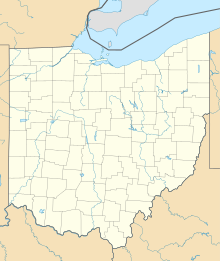Lockington locks
Coordinates: 40 ° 12 ′ 34 " N , 84 ° 14 ′ 38" W.
The Lockington Locks are a group of canal locks on the former Miami and Erie Canal in Lockington , Ohio in the United States . Construction began in 1833, and in 1845 the locks were put into operation for regular use. The lock system consisted of seven individual locks, six of which were at the northern end of a vertex and the seventh at its southern end. This is a six-kilometer section of the canal between Lockington in the very south of Shelby County and Washington Township on the northern edge of Miami County .
Buildings
The locks are located at the southern end of Loramie Summit, a 34 km long ridge that extends north from Lockington to New Bremen . Lockington was originally an important place on the canal: the village is at the point of connection with Loramie Creek, which was originally crossed by an aqueduct , and at the end of a feed channel that carries large quantities of water from Lewistown Reservoir near Ohio's highest Induced uprising in Logan County . The meeting point of the smaller canal with the larger one was created in Lockington, because the highest point of the Miama and Erie canal was located in the area of the apex stretch at 288 m above sea level. The northbound ships were raised in Lockington by a total of 20 m. In lock 48 they rose by three meters, in lock 49, 50 and 51 by 3.35 m each, and in lock 52 and 53 by 3.65 each. It usually took several hours to pass through the seven locks. The village of Lockington (originally Lockport ) was built to provide services to the waiting boatmen and their passengers. The individual locks were built from large limestone blocks , some of which weigh 230 kg, and equipped with wooden floors. The lock gates were made of American white oak .
Later story
The economic height of the Ohio canal system was reached in 1855. After that, ship operations continued to decline due to competition from the new rail transport ; even smaller towns like Lockington received train stations . A revival of the canal traffic was combined with a restoration of the facilities in the 1900s, but a catastrophic flood destroyed many structures on the canal in 1913 and dashed hopes for future economic use. Today the Lockington Locks and the surrounding land are a park, and the only water still flowing through the lock today is rainwater runoff after heavy rain . The landscape around the locks is relatively untouched, so converting the former towpath into a hiking trail is an option.
Monument status
In 1969, the Lockington Locks were entered on the National Register of Historic Places, making it the first in Miami County and Shelby County to be included in the register. Other sites related to the canal were later added to the register; the Piqua Historical Area State Memorial in Miami County was registered in 1971 and the Turtle Creek Culvert and Embankment in Shelby County in 1978 - the latter, however, removed from the register seven years later. The locks were also both for its contemporary significant engineering achievements as due to their importance for the region in terms History of Ohio as at the national level was added to the National Register of Historic Places.
Individual evidence
- ↑ a b National Register Information System. National Park Service .
- ↑ Lorrie K. Owen (Ed.): Dictionary of Ohio Historic Places ( English ), Volume Vol. 2 .. Somerset, St. Clair Shores ( Michigan ) 1999, p. 1013.
- ↑ a b c Travel Back in Time: Discover Ohio's Miami and Erie Canal ( English , PDF; 1.0 MB) Ohio Department of Natural Resources . Archived from the original on February 4, 2010. Info: The archive link was automatically inserted and not yet checked. Please check the original and archive link according to the instructions and then remove this notice. Retrieved March 2, 2011.
- ↑ a b c A.bc Hitchcock: History of Shelby County, Ohio and Representative Citizens ( English ). Richmond-Arnold, Chicago 1913 .
- ^ Richard Wallace: Making the Canal Locks ( English ) Shelby County Historical Society. December 1998. Retrieved March 2, 2011.
- ^ A b c History of Ohio's Canals ( English ) Ohio Department of Natural Resources . Archived from the original on March 24, 2012. Info: The archive link was inserted automatically and has not yet been checked. Please check the original and archive link according to the instructions and then remove this notice. Retrieved March 3, 2011.
- ↑ a b Lockington Locks Historical Area ( English ) Ohio Historical Society . 2007. Archived from the original on July 27, 2011. Info: The archive link was automatically inserted and has not yet been checked. Please check the original and archive link according to the instructions and then remove this notice. Retrieved March 3, 2011.


